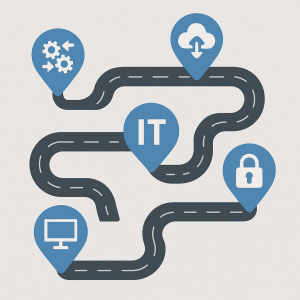A few years back, most owners thought of IT as background support, quietly keeping the lights on. Today it’s front-and-center in sales, service, marketing, and even reputation management. When the tech stalls, so does the business.
The risk extends past downtime or slow responses to customers. It’s the steady drip of missed efficiency and untapped opportunity. Without a plan, small businesses often buy tools on impulse to solve urgent issues, only to find they clash with existing systems, blow up budgets, or duplicate something already paid for.
 Think about the ripple effects:
Think about the ripple effects:
• Security gaps that invite trouble.
• Wasted spending on licenses nobody uses.
• Systems that choke when growth takes off.
• Customer delays that leave a poor impression.
If that list feels uncomfortably familiar, you’re not alone. The real question isn’t whether to create an IT roadmap; it’s how fast you can build one that actually moves your business forward to the right direction. At its core, an IT roadmap is about connection: linking your business goals, technology, and people so they work toward the same outcomes.
Done well, it:
• Keeps technology spending focused on what matters most.
• Prevents redundancy and streamlines operations.
• Improves the customer experience through better tools and integration.
• Prepares you to adapt quickly when new technology or opportunities emerge.
If you’ve been running without a plan, the good news is you can start small: set a goal, take inventory, and map the first few steps. You don’t have to have everything perfect right away. What matters is moving from reaction mode to intentional, strategic action.
Contact us to start building a future ready IT roadmap that turns your technology from a patchwork of tools into a true growth engine for your business.
